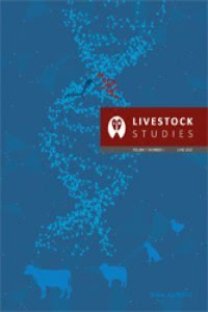ETLİK PİLİÇLERDE CİNSİYET, YAŞ VE ERKEN DÖNEMDE PROTEİN KISITLAMASININ BAZI İÇ ORGANLAR, ETİN KİMYASAL KOMPOZİSYONU VE AYAK LEZYONLARI ÜZERİNE ETKİSİ
Bu araştırma, etlik piliçlerde cinsiyet gruplarının ayrı büyütülmesinin ve yemdeki protein kısıtlamasının farklı iki kesim yaşında iç organ oranları, ette protein, yağ, kurumadde, kül oranlarını ve piliçlerin ayak sorunları üzerine etkisini belirlemek amacıyla yapılmıştır. Araştırmada 360 adet 1 günlük erkek ve dişi civciv, kontrol(K), deneme 1(D1) ve deneme 2(D2) gruplarına ayrılmıştır. Tüm gruplara 1-10. günlerde % 23.10; 11-30. günlerde ise K, D1 ve D2’ye sırasıyla % 21.80, 20.20 ve 18.40 ham proteinli rasyon verilmiştir. 31-47. günler arasında tüm gruplara % 18.40 ham proteinli rasyon uygulanmıştır. Metabolik enerji ise 1-10.günlerde 3083.69kcal/kg; 11-30. günlerde kontrol (K), deneme 1 (D1) ve deneme 2 (D2) gruplarına sırasıyla 3095.66; 3117.80 ve 3120.55 kcal/kg; 31-47. günlerde ise 3120.55 kcal/kg olarak uygulanmıştır. Kesim yaşı gruplarında taşlık (P taşlık (P<0.01), kalp (P<0.001) ve karaciğer oranı (P<0.001) arasındaki fark istatistiksel olarak önemli bulunmuştur. Cinsiyet gruplarında ise sadece kalp oranı (P<0.05) önemlidir. Besleme gruplarında taşlık, karaciğer ve kalp oranları arasında fark tespit edilmemiştir (P>0.05). Etin kimyasal kompozisyonu bakımından, besleme ve kesim yaşı gruplarında yağ oranı ortalamaları arasındaki fark önemsiz (P>0.05), cinsiyet grupları arasındaki fark ise önemli bulunmuştur (P<0.05). Kül oranı, kesim yaşı (P<0.01) ve besleme gruplarında (P<0.001) önemli iken cinsiyet grupları arasındaki fark önemsiz bulunmuştur. Protein ve kuru madde oranları kesim yaşı ve cinsiyet gruplarında önemsiz iken besleme grupları arasındaki fark önemlidir (P<0.05; P<0.001). Protein oranı yüksek olan rasyonla beslenen gruplarda, ayak lezyonları görülme oranları yüksek olmasına rağmen, gruplar arasındaki farklılık istatistik olarak önemsiz bulunmuştur (P>0.05). Sonuç olarak, iç organlar ve etin kimyasal kompozisyonu bakımından % 20 protein uygulanan grupların 40 günlük kesim yaşında kesime sevk edilmesi tavsiye edilebilir.
Anahtar Kelimeler:
Etlik piliç, etin kimyasal kompozisyonu, iç organlar, protein kısıtlaması
The effects of sex, age and early protein restriction on some visceral organs, meat chemicalcomposition and foot lesions in broilers chickens
This research was conducted to determine the effect of sex separate rearing of broiler chicken and dietary protein restriction in two different slaughter age on visceral organs, meat protein, fat, dry matter, ash and foot problems. One-day old, 360 male and female chicks were divided to control (K), experiment 1 (D1) and experiment 2 (D2) groups. All groups were feed on 23.10 % crude protein dietary between 1-10th days of age. The protein percentage of the crude protein for the K, D1, D2 groups were 21.80 %, 20.20 % and 18.40 % crude protein between 11-30th days of age respectively. Also, chickens fed with % 18.40 crude protein from 32 to 47 days of age. As for metabolic energy levels were 3083.69 kcal/kg between 1-10th days of age. 11-30th days of age for the K, D1, D2 groups were 3095.66; 3117.80 and 3120.55 kcal/kg respectively. All groups metabolic energy levels were 3120.55 kcal /kg between 32-47th days of age. All chickens were slaughtered at 40 and 47 days of age. Gizzard (P<0.01), heart (P<0.001) and liver rate (P<0.001) were significant determinate for slaughter age. Hearth rate was significant determinate while liver rate and gizzard rate were not significant determinate for sex groups. In respect to the chemical composition of meat, fatty rate means were not significant to treatment and slaughter groups (P>0.05) and those of were found to significant for sex groups (P<0.05). Ash rate was significant to treatment and slaughter age groups while that of was not found to significant for sex groups. Protein and dry matter rate were not significant for slaughter age and sex groups while between treatment groups was significant (P<0.05; P<0.001). In respect of the high percentage of the foot lesions appered in the groups fed with high protein diet. In conclusion, in respect to visceral organs and the chemical composition of meat can recommend to 40 days slaughter age and 20% crude protein for experimental groups
Keywords:
Broiler, meat chemical composition, restricted protein, visceral organs,
- Yayın Aralığı: Yılda 2 Sayı
- Başlangıç: 1959
- Yayıncı: Sezer ÖZ
Sayıdaki Diğer Makaleler
RUMİNANT HAYVAN BESLEMEDE ORGANİK İZ MİNERALLERİN ÖNEMİ (DERLEME)
Mustafa UĞURLU, Fatih ATASOY, Akın YAKAN, Aytaç AKÇAY
ORTA ANADOLU ŞARTLARINDA ACIPAYAM KOYUNLARININ BAZI VERİM ÖZELLİKLERİ
Fatma Tülin ÖZBAŞER, Halil AKÇAPINAR
Esin Ebru ONBAŞILAR, Özlem Varol AVCILAR
